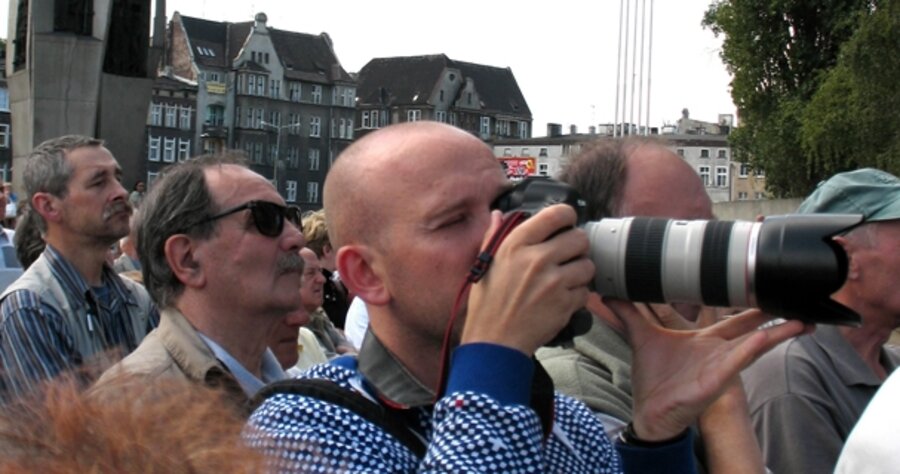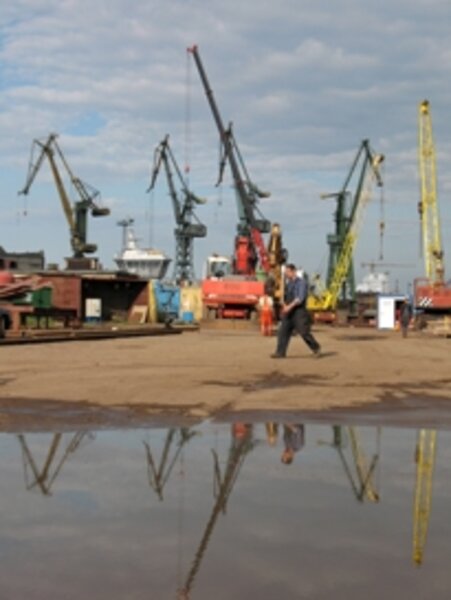Artists try to save Gdansk shipyards – in images
Loading...
| Gdansk, Poland
Gdansk, Poland
When Michal Szlaga got his first job at the Gdansk shipyards five years ago, he was fresh out of the arts academy, a struggling photographer desperate for money. He was hired as a shipyard painter, a job that required getting up at 4 a.m. for a day of punishing manual labor in the harsh winter of northern Poland. One morning he woke up crying.
He lasted eight days. Then he quit.
But Mr. Szlaga couldn’t leave; he may not have been able to hack it as a painter, but as a photographer he was hooked. This giant industrial complex – site of the beginning of the end of the communist Bloc – holds a hallowed place in Poland’s collective memory, even as it disappears off this nation’s economic map.
“These are the most recognized shipyard workers in the world. They are heroes for some people,” Szlaga says, explaining why he traded winches and blowtorches for his camera and began documenting the men and women who spent their lives there. “I realized I could only take pictures. It’s all I could do here, really.”
He’s not alone. For seven years, a colony of artists like him have lived and worked among the towering cranes and 19th century buildings.
For Poland, and most of the Western world, the Gdansk shipyards are much more than a place to build ships – they’re the cradle of the legendary Solidarity Movement. Here in 1980, an electrician named Lech Walesa led 17,000 workers in a series of strikes that triggered the disintegration of communism in Eastern Europe and Russia. Solidarity become a powerful political force, launching Mr. Walesa into international prominence. He won a Nobel Peace Prize in 1983, and the Polish presidency in 1990.
Today the shipyards are fighting again – this time for their very survival. Financially stricken by the breakup of the Soviet Union and rapid privatization, only five ships were built here last year, down from 35 a year during the 1970s. Where 20,000 people once worked, today there are around 3,000. There’s a very real possibility the shipyards will soon close down completely.
It’s a call to action for Szlaga.
“This place is an obsession because it’s disappearing,” he says. “The more it disappears, the more photos I want to take. They keep knocking down buildings, so I feel like I have to.”
Looking through his pictures, you start to understand: Faces covered in grease and creased by decades of hard labor look directly into the camera, unsmiling. These are stark images of shipyard work – men and metal in a surreal landscape of oversized machinery and crumbling buildings. The compelling photos have gained international notice – Szlaga won a prestigious Lucie Award this year and exhibits in the US, Austria, and Sweden.
• • •
This marriage of art and industry began in 2001, when management decided to rejuvenate the grounds by renting out cheap studios to artists. Szlaga and 25 other photographers, painters, dancers, and architects moved in. They all lived and worked together in a building only a few hundred feet from where Walesa signed his landmark agreements with the communist authorities.
“We were the first [artists] here,” explains Szlaga. “That’s why people were so enthusiastic about creating something. The atmosphere was magic, extraordinary.”
For other shipyard artists, the appeal of the derelict industrial site is less historical than physical. Konrad Zientara, an architect, has lived on the grounds for five years, and, for him, the allure is in “the space, the views, the holes, the cranes, the platforms that carry pieces of ships, the special things that are only here ... people don’t see the space and the beauty of it, because the only thing you hear about is the history. The events were important, but I think the place suffers from them.”
Many of the original leaders of Solidarity are still doing the same jobs they did three decades ago: riveting, painting, and welding ships. In 2005, when the Polish political elite descended on Gdansk to mark the 25th anniversary of the strikes with elaborate ceremonies, the workers themselves were urged to stay home.
“I think people like to remember symbols, but the symbolic worker isn’t connected to the real worker,” muses Mr. Zientara. Seen as grimy, uneducated, and often drunk, today’s shipyard worker isn’t considered fit to be a national icon.
It is precisely this reality gap that many of the resident artists attempt to bridge. In a northern neighborhood of Gdansk, an area of abandoned brick tenements overgrown with weeds, a mural by Iwona Zajac stretches along a roadside wall. In simple black and blue, the artist intersperses shipyard scenes with the words of the workers themselves – most filled with memories and strong sense of belonging: “I never thought I would work for 42 years in the same place.” “I have a feeling there’s a piece of me in every ship we built.” “I will miss the place. When I retire I won’t know what to do with myself.”
The mural has become a favorite among the workers. “When I walk along the wall I feel like crying, because it’s the truth,” says Zbyszek Stefanski, a ship painter since 1974. “The artists are great! Young people who had no idea what was going on in here did a lot of good for the shipyards.”
But those days are coming to an end. In January the artists’ colony was broken up to make room for offices, and the artists themselves were obliged to find new studios. Some, like Szlaga, stayed on the shipyard grounds; others moved away.
The yards themselves may face an even bleaker future. In an ironic twist, the very victory that ensured the Gdansk shipyards a place in history is also destroying them. Since the collapse of the USSR, the yards have struggled to compete in other markets. State aid has kept them afloat, but Poland joined the European Union in 2004 and is now forced to adhere to Europe’s stringent regulations regarding free market competition.
Earlier this month, the Polish treasury, in a last-ditch effort to save the yards, submitted a restructuring plan to the European Commission. If it isn’t approved, the Gdansk shipyards will be ordered to pay back $300 million in state aid received over the years – money long gone. Such a ruling would mean almost certain bankruptcy and an end to shipbuilding.
• • •
On Sept. 9, several hundred people gathered at the foot of Gdansk’s monument to fallen shipyard workers to protest the potential closure of the yards. Emotions ran high. At the edge of the crowd stood 68-year-old Pawel Zinczuk, his white hair and frail frame at odds with the burly men around him. Mr. Zinczuk’s shipyard career has spanned 35 years. In 1980 he was a key strike organizerand spent six months in prison for dissident activities.
When asked how he felt about the current situation, his eyes filled with tears: “In 1996, I was laid off. After my last day, I sat on this monument for three hours, and I was so upset I had a heart attack. It’s a very hard time for me now because I feel the same way ... the shipyard was my family and my home.”
Several years ago, the resident artists organized an exhibition called “Dockwatchers,” a collection of works underscoring their ambivalence toward the legend of Solidarity and the course of recent history.
Szlaga’s photographs were there, among them a portrait of working-class hero Anna Walentynowicz whose radical politics and consequent dismissal ignited the 1980 strikes.
In the picture, she stands beneath the mouldering brick arches and broken windows of an old shipyard building, a diminutive elderly lady with a fierce look in her eyes – not unlike the Gdansk shipyards, themselves, a powerful place, fading from national importance.






